Enhanced Photodetection Range from Visible to Shortwave Infrared Light by ReSe2/MoTe2 van der Waals Heterostructure
Abstract
:1. Introduction
2. Results and Discussion
3. Conclusions
4. Experimental Details
4.1. Preparation of the ReSe2/MoTe2 Heterostructure Photodetector
4.2. Characterization
Supplementary Materials
Author Contributions
Funding
Institutional Review Board Statement
Informed Consent Statement
Data Availability Statement
Acknowledgments
Conflicts of Interest
References
- Wu, E.; Wu, D.; Jia, C.; Wang, Y.; Yuan, H.; Zeng, L.; Xu, T.S.; Li, X. In Situ Fabrication of 2D WS2/Si Type-II Heterojunction for Self-Powered Broadband Photodetector with Response up to Mid-Infrared. ACS Photonics 2019, 6, 565–572. [Google Scholar] [CrossRef] [Green Version]
- Su, B.W.; Li, X.K.; Jiang, X.Q.; Xin, W.; Huang, K.X.; Li, D.K.; Guo, H.W.; Liu, Z.B.; Tian, J.G. Carrier Engineering in Polarization-Sensitive Black Phosphorus van der Waals Junctions. ACS Appl. Mater. Interfaces 2018, 10, 35615–35622. [Google Scholar] [CrossRef] [PubMed]
- Kim, Y.; Lee, S.; Song, J.G.; Ko, K.Y.; Woo, W.J.; Lee, S.W.; Park, M.; Lee, H.; Lee, Z.; Choi, H.; et al. 2D Transition Metal Dichalcogenide Heterostructures for p- and n-Type Photovoltaic Self-Powered Gas Sensor. Adv. Funct. Mater. 2020, 30, 2003360. [Google Scholar] [CrossRef]
- Ji, F.; Ren, X.; Zheng, X.; Liu, Y.; Pang, L.; Jiang, J.; Liu, S.F. 2D-MoO3 nanosheets for superior gas sensors. Nanoscale 2016, 8, 8696–8703. [Google Scholar] [CrossRef] [PubMed]
- Shanmugam, M.; Jacobs-Gedrim, R.; Song, E.S.; Yu, B. Two-dimensional layered semiconductor/graphene heterostructures for solar photovoltaic applications. Nanoscale 2014, 6, 12682–12689. [Google Scholar] [CrossRef]
- Furchi, M.M.; Pospischil, A.; Libisch, F.; Burgdorfer, J.; Mueller, T. Photovoltaic effect in an electrically tunable van der Waals heterojunction. Nano Lett. 2014, 14, 4785–4791. [Google Scholar] [CrossRef]
- Tian, H.; Tice, J.; Fei, R.; Tran, V.; Yan, X.; Yang, L.; Wang, H. Low-symmetry two-dimensional materials for electronic and photonic applications. Nano Today 2016, 11, 763–777. [Google Scholar] [CrossRef] [Green Version]
- Koppens, F.H.; Mueller, T.; Avouris, P.; Ferrari, A.C.; Vitiello, M.S.; Polini, M. Photodetectors based on graphene, other two-dimensional materials and hybrid systems. Nat. Nanotechnol. 2014, 9, 780–793. [Google Scholar] [CrossRef]
- Li, R.; Li, L.J.; Cheng, Y.; Huang, W. Recent Advances in van der Waals Heterojunctions Based on Semiconducting Transition Metal Dichalcogenides. Adv. Electron. Mater. 2018, 4, 1800270. [Google Scholar] [CrossRef]
- Wang, C.; Yang, F.; Gao, Y. The highly-efficient light-emitting diodes based on transition metal dichalcogenides: From architecture to performance. Nanoscale Adv. 2020, 2, 4323–4340. [Google Scholar] [CrossRef]
- Mak, K.F.; Shan, J. Photonics and optoelectronics of 2D semiconductor transition metal dichalcogenides. Nat. Photonics 2016, 10, 216–226. [Google Scholar] [CrossRef]
- Li, X.; Chen, C.; Yang, Y.; Lei, Z.; Xu, H. 2D Re-Based Transition Metal Chalcogenides: Progress, Challenges, and Opportunities. Adv. Sci. 2020, 7, 2002320. [Google Scholar] [CrossRef]
- Arora, A.; Noky, J.; Druppel, M.; Jariwala, B.; Deilmann, T.; Schneider, R.; Schmidt, R.; Del Pozo-Zamudio, O.; Stiehm, T.; Bhattacharya, A.; et al. Highly Anisotropic in-Plane Excitons in Atomically Thin and Bulklike 1T’-ReSe2. Nano Lett. 2017, 17, 3202–3207. [Google Scholar] [CrossRef]
- Jiang, S.; Zhang, Z.; Zhang, N.; Huan, Y.; Gong, Y.; Sun, M.; Shi, J.; Xie, C.; Yang, P.; Fang, Q.; et al. Application of chemical vapor–deposited monolayer ReSe2 in the electrocatalytic hydrogen evolution reaction. Nano Res. 2018, 11, 1787–1797. [Google Scholar] [CrossRef]
- Kang, B.; Kim, Y.; Cho, J.H.; Lee, C. Ambipolar transport based on CVD-synthesized ReSe2. 2D Mater. 2017, 4, 025014. [Google Scholar] [CrossRef]
- Jariwala, B.; Voiry, D.; Jindal, A.; Chalke, B.A.; Bapat, R.; Thamizhavel, A.; Chhowalla, M.; Deshmukh, M.; Bhattacharya, A. Synthesis and Characterization of ReS2 and ReSe2 Layered Chalcogenide Single Crystals. Chem. Mater. 2016, 28, 3352–3359. [Google Scholar] [CrossRef]
- Yang, S.; Tongay, S.; Li, Y.; Yue, Q.; Xia, J.B.; Li, S.S.; Li, J.; Wei, S.H. Layer-dependent electrical and optoelectronic responses of ReSe2 nanosheet transistors. Nanoscale 2014, 6, 7226–7231. [Google Scholar] [CrossRef]
- Jo, S.H.; Park, H.Y.; Kang, D.H.; Shim, J.; Jeon, J.; Choi, S.; Kim, M.; Park, Y.; Lee, J.; Song, Y.J.; et al. Broad Detection Range Rhenium Diselenide Photodetector Enhanced by (3-Aminopropyl)Triethoxysilane and Triphenylphosphine Treatment. Adv. Mater. 2016, 28, 6711–6718. [Google Scholar] [CrossRef]
- Zhang, E.; Wang, P.; Li, Z.; Wang, H.; Song, C.; Huang, C.; Chen, Z.G.; Yang, L.; Zhang, K.; Lu, S.; et al. Tunable Ambipolar Polarization-Sensitive Photodetectors Based on High-Anisotropy ReSe2 Nanosheets. ACS Nano 2016, 10, 8067–8077. [Google Scholar] [CrossRef]
- Shih, C.-C.; Huang, M.-H.; Wan, C.-K.; Jian, W.-B.; Kono, K.; Lin, Y.-F.; Ho, C.-H. Tuning Interface Barrier in 2D BP/ReSe2 Heterojunctions in Control of Optoelectronic Performances and Energy Conversion Efficiencies. ACS Photonics 2020, 7, 2886–2895. [Google Scholar] [CrossRef]
- Kufer, D.; Nikitskiy, I.; Lasanta, T.; Navickaite, G.; Koppens, F.H.; Konstantatos, G. Hybrid 2D-0D MoS2-PbS quantum dot photodetectors. Adv. Mater. 2015, 27, 176–180. [Google Scholar] [CrossRef]
- Zhang, K.; Zhang, T.; Cheng, G.; Li, T.; Wang, S.; Wei, W.; Zhou, X.; Yu, W.; Sun, Y.; Wang, P.; et al. Interlayer Transition and Infrared Photodetection in Atomically Thin Type-II MoTe2/MoS2 van der Waals Heterostructures. ACS Nano 2016, 10, 3852–3858. [Google Scholar] [CrossRef]
- Long, M.; Liu, E.; Wang, P.; Gao, A.; Xia, H.; Luo, W.; Wang, B.; Zeng, J.; Fu, Y.; Xu, K.; et al. Broadband Photovoltaic Detectors Based on an Atomically Thin Heterostructure. Nano Lett. 2016, 16, 2254–2259. [Google Scholar] [CrossRef]
- Chen, Z.; Li, X.; Wang, J.; Tao, L.; Long, M.; Liang, S.-J.; Ang, L.K.; Shu, C.; Tsang, H.K.; Xu, J.-B. Synergistic Effects of Plasmonics and Electron Trapping in Graphene Short-Wave Infrared Photodetectors with Ultrahigh Responsivity. ACS Nano 2017, 11, 430–437. [Google Scholar] [CrossRef]
- Khan, M.F.; Rehman, S.; Akhtar, I.; Aftab, S.; Ajmal, H.M.S.; Khan, W.; Kim, D.-k.; Eom, J. High mobility ReSe2 field effect transistors: Schottky-barrier-height-dependent photoresponsivity and broadband light detection with Co decoration. 2D Mater. 2019, 7, 015010. [Google Scholar] [CrossRef]
- Lin, X.; Wang, F.; Shan, X.; Miao, Y.; Chen, X.; Yan, M.; Zhang, L.; Liu, K.; Luo, J.; Zhang, K. High-performance photodetector and its optoelectronic mechanism of MoS2/WS2 vertical heterostructure. Appl. Surf. Sci. 2021, 546, 149074. [Google Scholar] [CrossRef]
- Du, C.; Gao, H.; Du, W.; Li, J.; Leng, J.; Li, K.; Wang, W. High responsivity and broadband polarized photodetectors based on InSe/ReSe2 van der Waals heterostructures. J. Alloys Compd. 2022, 919, 165586. [Google Scholar] [CrossRef]
- Elahi, E.; Khan, M.F.; Rehman, S.; Khalil, H.M.W.; Rehman, M.A.; Kim, D.K.; Kim, H.; Khan, K.; Shahzad, M.; Iqbal, M.W.; et al. Enhanced electrical and broad spectral (UV-Vis-NIR) photodetection in a Gr/ReSe2/Gr heterojunction. Dalton Trans. 2020, 49, 10017–10027. [Google Scholar] [CrossRef]
- Afzal, A.M.; Iqbal, M.Z.; Dastgeer, G.; Nazir, G.; Eom, J. Ultrafast and Highly Stable Photodetectors Based on p-GeSe/n-ReSe2 Heterostructures. ACS Appl. Mater. Interfaces 2021, 13, 47882–47894. [Google Scholar] [CrossRef]
- Jiang, S.; Hong, M.; Wei, W.; Zhao, L.; Zhang, N.; Zhang, Z.; Yang, P.; Gao, N.; Zhou, X.; Xie, C.; et al. Direct synthesis and in situ characterization of monolayer parallelogrammic rhenium diselenide on gold foil. Commun. Chem. 2018, 1, 1–8. [Google Scholar] [CrossRef]
- Li, A.; Chen, Q.; Wang, P.; Gan, Y.; Qi, T.; Wang, P.; Tang, F.; Wu, J.Z.; Chen, R.; Zhang, L.; et al. Ultrahigh-Sensitive Broadband Photodetectors Based on Dielectric Shielded MoTe2/Graphene/SnS2 p-g-n Junctions. Adv. Mater. 2019, 31, e1805656. [Google Scholar] [CrossRef]
- Nguyen, T.T.; Patel, M.; Kim, S.; Mir, R.A.; Yi, J.; Dao, V.-A.; Kim, J. Transparent photovoltaic cells and self-powered photodetectors by TiO2/NiO heterojunction. J. Power Sources 2021, 481, 228865. [Google Scholar] [CrossRef]
- Gao, Y.; Xu, J.; Shi, S.; Dong, H.; Cheng, Y.; Wei, C.; Zhang, X.; Yin, S.; Li, L. TiO2 Nanorod Arrays Based Self-Powered UV Photodetector: Heterojunction with NiO Nanoflakes and Enhanced UV Photoresponse. ACS Appl. Mater. Interfaces 2018, 10, 11269–11279. [Google Scholar] [CrossRef]
- Zhang, H.; Zhang, X.; Liu, C.; Lee, S.T.; Jie, J. High-Responsivity, High-Detectivity, Ultrafast Topological Insulator Bi2Se3/Silicon Heterostructure Broadband Photodetectors. ACS Nano 2016, 10, 5113–5122. [Google Scholar] [CrossRef]
- Xie, C.; Zeng, L.; Zhang, Z.; Tsang, Y.H.; Luo, L.; Lee, J.H. High-performance broadband heterojunction photodetectors based on multilayered PtSe2 directly grown on a Si substrate. Nanoscale 2018, 10, 15285–15293. [Google Scholar] [CrossRef]
- Lee, J.; Duong, N.T.; Bang, S.; Park, C.; Nguyen, D.A.; Jeon, H.; Jang, J.; Oh, H.M.; Jeong, M.S. Modulation of Junction Modes in SnSe2/MoTe2 Broken-Gap van der Waals Heterostructure for Multifunctional Devices. Nano Lett. 2020, 20, 2370–2377. [Google Scholar] [CrossRef]
- Ahn, J.; Ko, K.; Kyhm, J.H.; Ra, H.S.; Bae, H.; Hong, S.; Kim, D.Y.; Jang, J.; Kim, T.W.; Choi, S.; et al. Near-Infrared Self-Powered Linearly Polarized Photodetection and Digital Incoherent Holography Using WSe2/ReSe2 van der Waals Heterostructure. ACS Nano 2021, 15, 17917–17925. [Google Scholar] [CrossRef]
- Cho, A.-J.; Namgung, S.D.; Kim, H.; Kwon, J.-Y. Electric and photovoltaic characteristics of a multi-layer ReS2/ReSe2 heterostructure. APL Mater. 2017, 5, 076101. [Google Scholar] [CrossRef] [Green Version]
- Wang, X.; Huang, L.; Peng, Y.; Huo, N.; Wu, K.; Xia, C.; Wei, Z.; Tongay, S.; Li, J. Enhanced rectification, transport property and photocurrent generation of multilayer ReSe2/MoS2 p–n heterojunctions. Nano Res. 2015, 9, 507–516. [Google Scholar] [CrossRef]
- Afzal, A.M.; Javed, Y.; Akhtar Shad, N.; Iqbal, M.Z.; Dastgeer, G.; Munir Sajid, M.; Mumtaz, S. Tunneling-based rectification and photoresponsivity in black phosphorus/hexagonal boron nitride/rhenium diselenide van der Waals heterojunction diode. Nanoscale 2020, 12, 3455–3468. [Google Scholar] [CrossRef]
- Li, K.; Du, C.; Gao, H.; Yin, T.; Zheng, L.; Leng, J.; Wang, W. Ultrafast and Polarization-Sensitive ReS2/ReSe2 Heterostructure Photodetectors with Ambipolar Photoresponse. ACS Appl. Mater. Interfaces 2022, 14, 33589–33597. [Google Scholar] [CrossRef] [PubMed]
- Tian, X.; Liu, Y. Van der Waals heterojunction ReSe2/WSe2 polarization-resolved photodetector. J. Semicond. 2021, 42, 032001. [Google Scholar] [CrossRef]
- Jaffery, S.H.A.; Dastgeer, G.; Hussain, M.; Ali, A.; Hussain, S.; Ali, M.; Jung, J. Near-Direct Band Alignment of MoTe2/ReSe2 Type-II p-n Heterojunction for Efficient VNIR Photodetection. Adv. Mater. Technol. 2022, 2200026. [Google Scholar] [CrossRef]
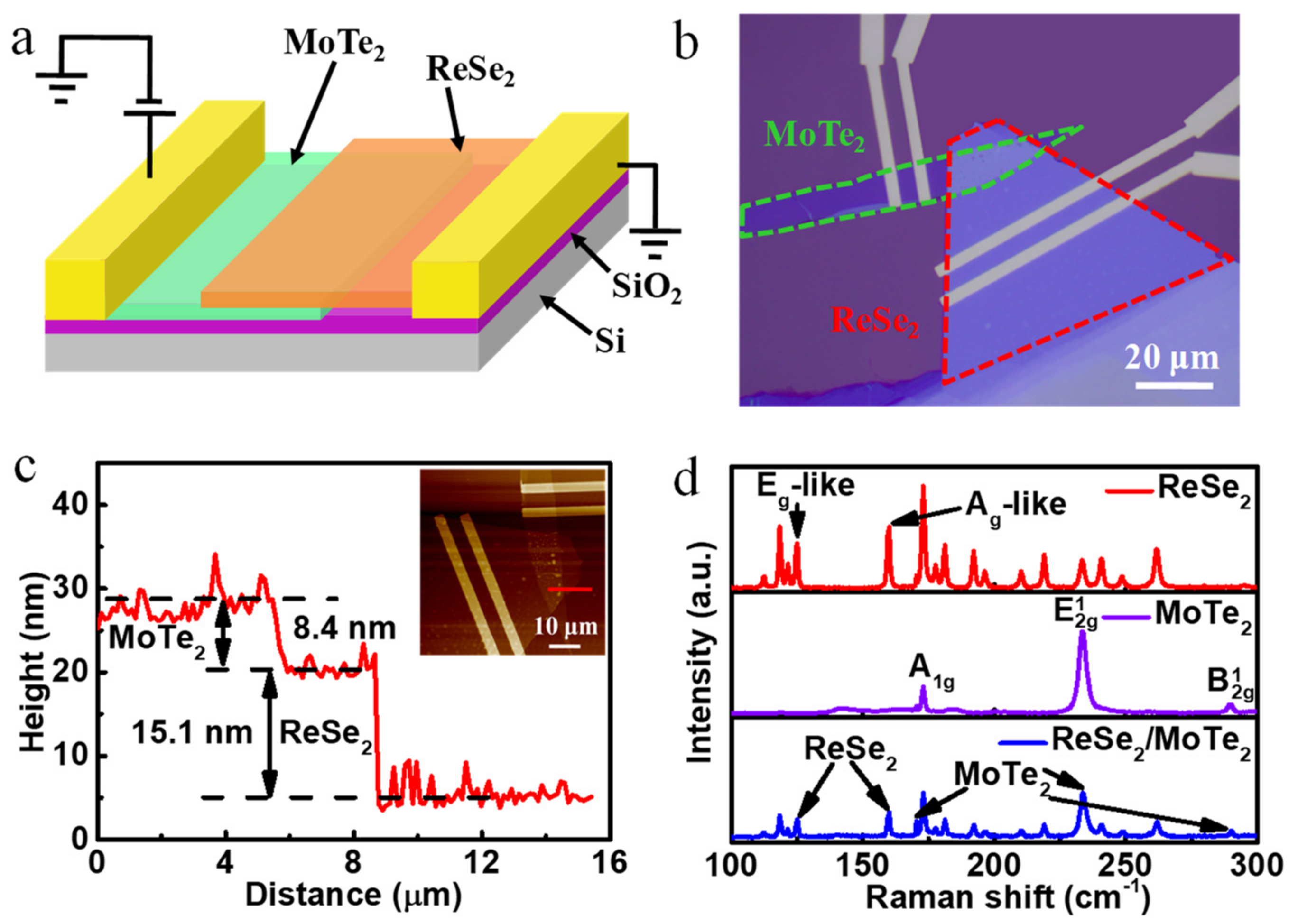
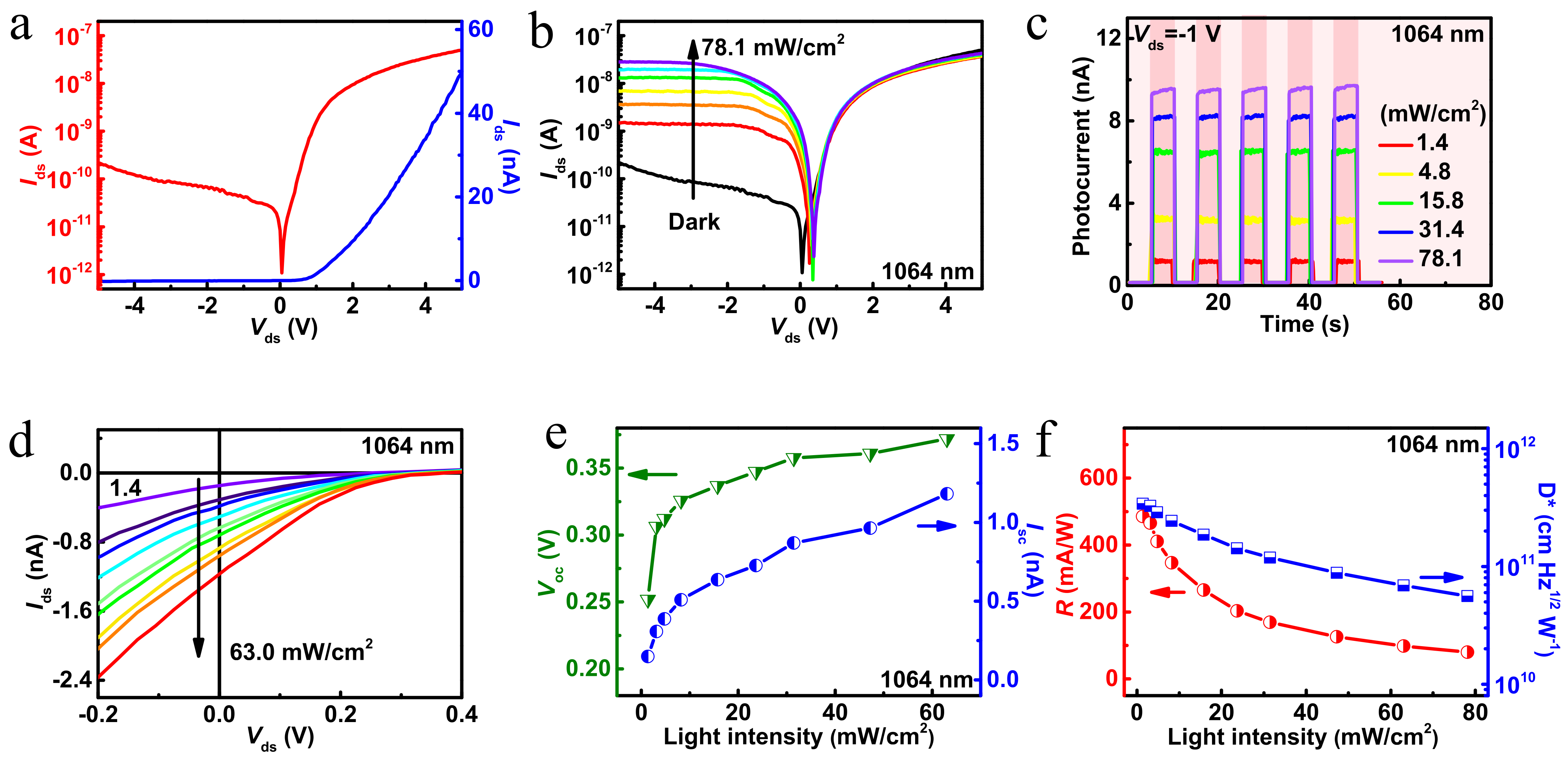
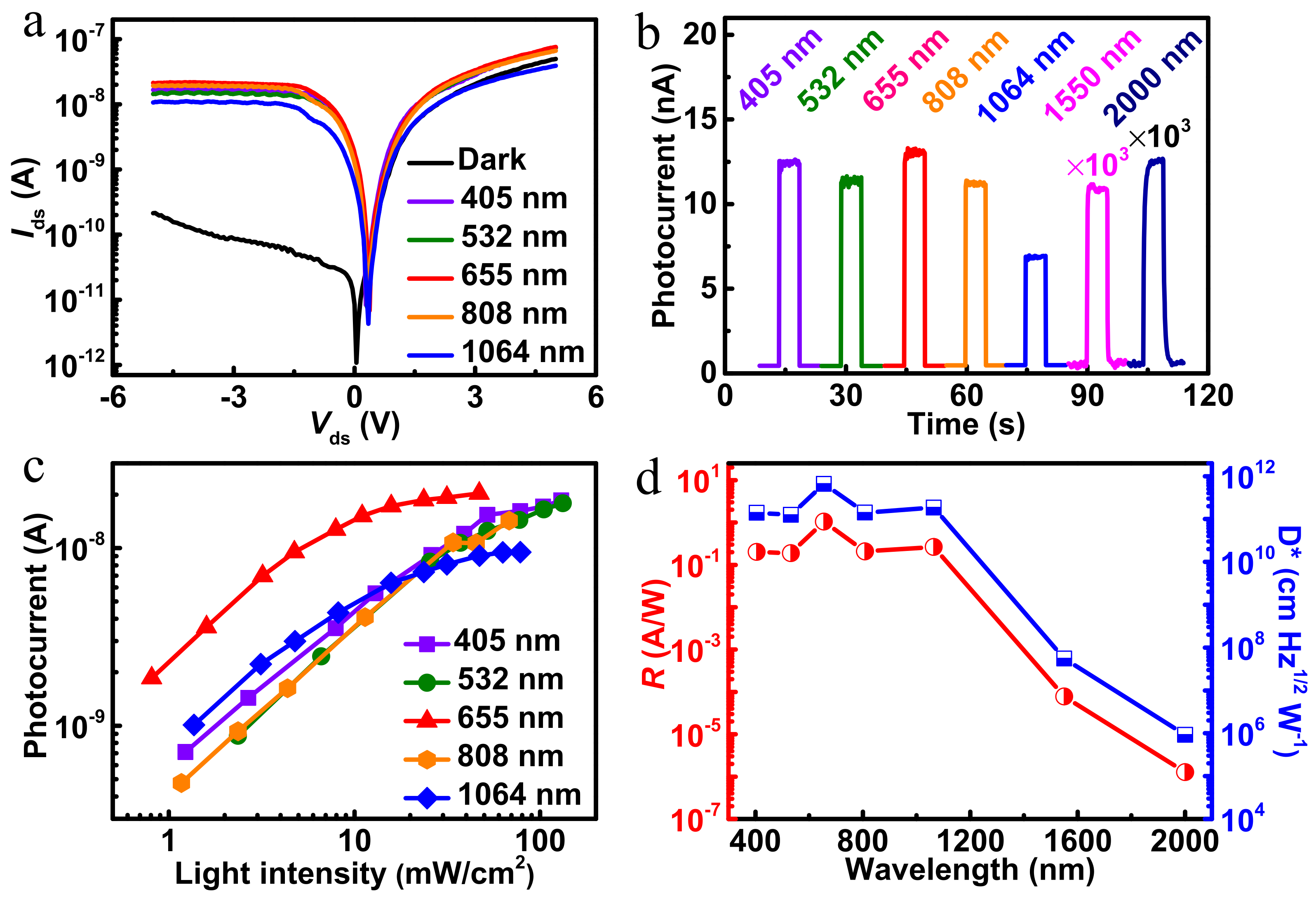
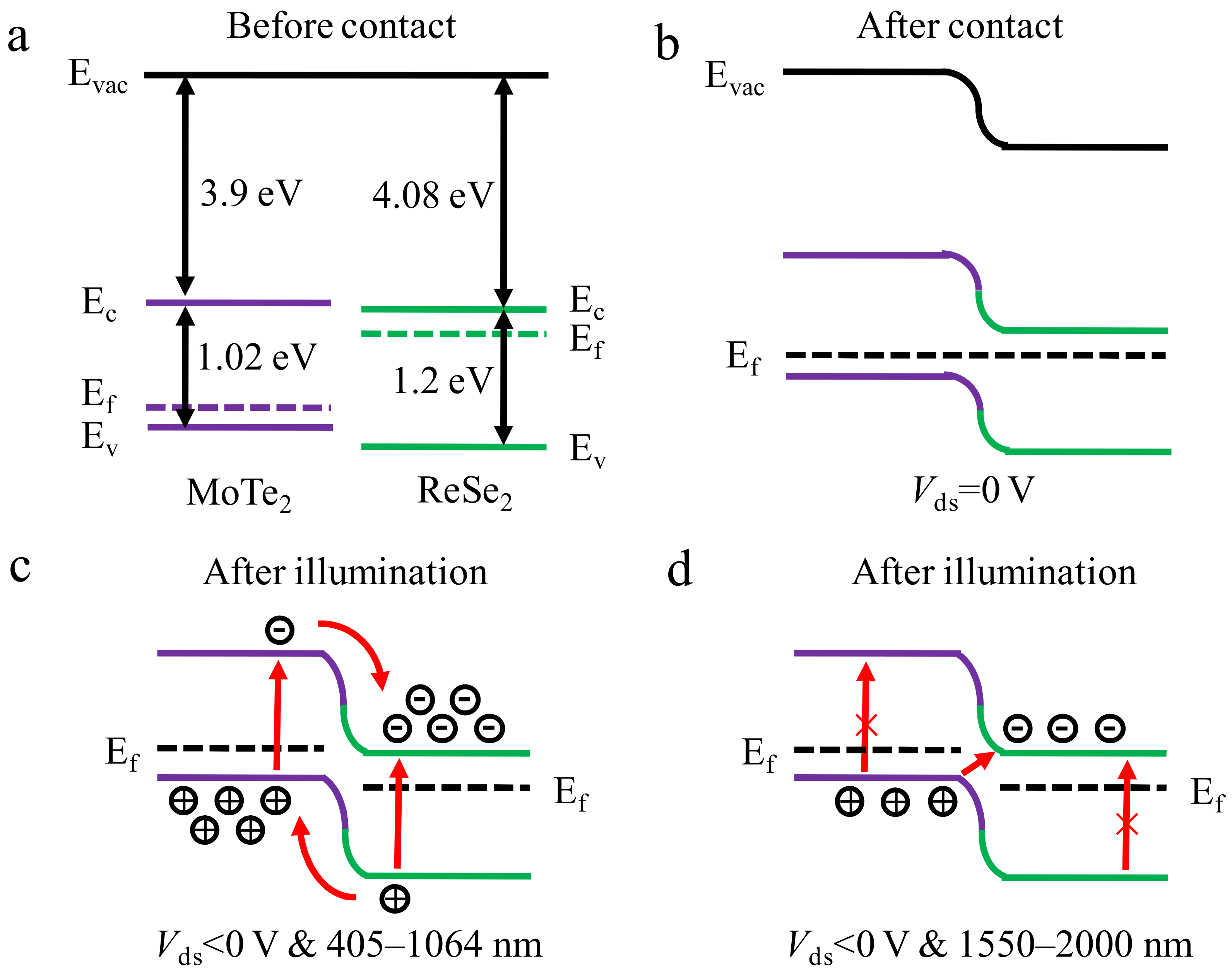
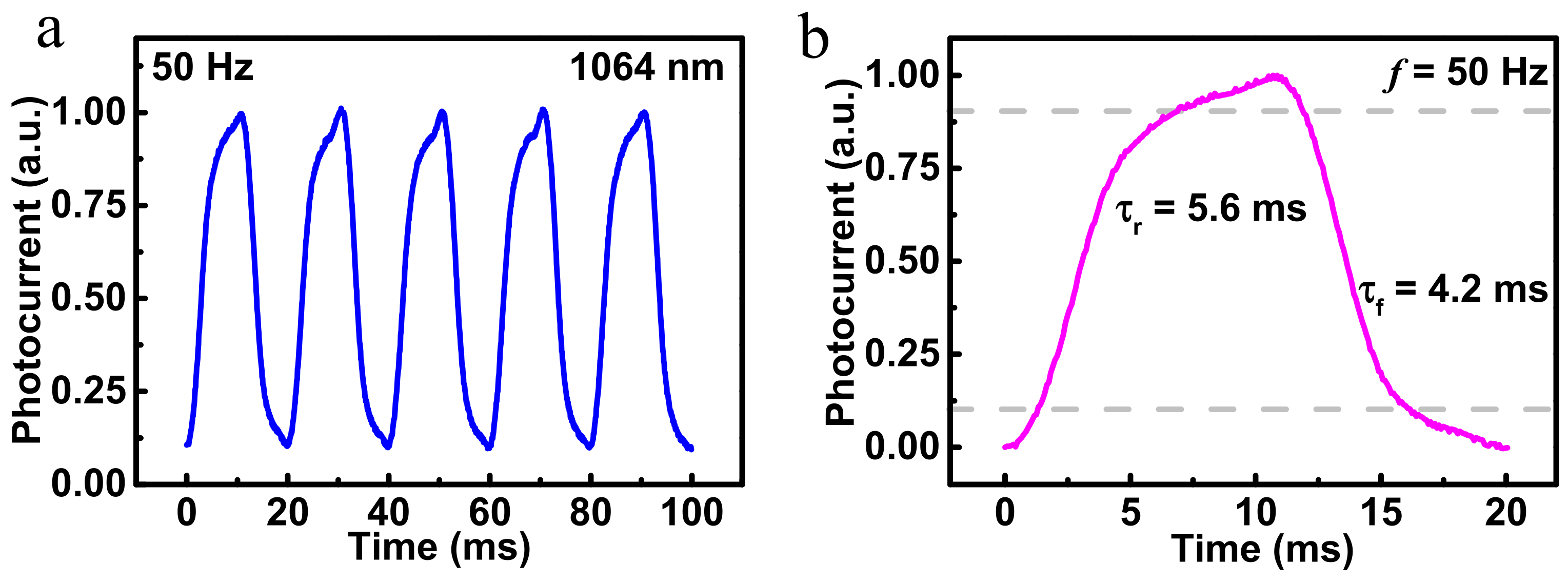
Publisher’s Note: MDPI stays neutral with regard to jurisdictional claims in published maps and institutional affiliations. |
© 2022 by the authors. Licensee MDPI, Basel, Switzerland. This article is an open access article distributed under the terms and conditions of the Creative Commons Attribution (CC BY) license (https://creativecommons.org/licenses/by/4.0/).
Share and Cite
Lin, Z.; Zhu, W.; Zeng, Y.; Shu, Y.; Hu, H.; Chen, W.; Li, J. Enhanced Photodetection Range from Visible to Shortwave Infrared Light by ReSe2/MoTe2 van der Waals Heterostructure. Nanomaterials 2022, 12, 2664. https://doi.org/10.3390/nano12152664
Lin Z, Zhu W, Zeng Y, Shu Y, Hu H, Chen W, Li J. Enhanced Photodetection Range from Visible to Shortwave Infrared Light by ReSe2/MoTe2 van der Waals Heterostructure. Nanomaterials. 2022; 12(15):2664. https://doi.org/10.3390/nano12152664
Chicago/Turabian StyleLin, Zhitao, Wenbiao Zhu, Yonghong Zeng, Yiqing Shu, Haiguo Hu, Weicheng Chen, and Jianqing Li. 2022. "Enhanced Photodetection Range from Visible to Shortwave Infrared Light by ReSe2/MoTe2 van der Waals Heterostructure" Nanomaterials 12, no. 15: 2664. https://doi.org/10.3390/nano12152664
APA StyleLin, Z., Zhu, W., Zeng, Y., Shu, Y., Hu, H., Chen, W., & Li, J. (2022). Enhanced Photodetection Range from Visible to Shortwave Infrared Light by ReSe2/MoTe2 van der Waals Heterostructure. Nanomaterials, 12(15), 2664. https://doi.org/10.3390/nano12152664





